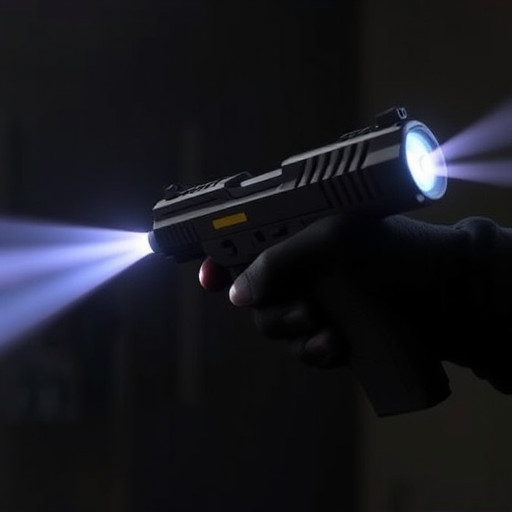Stun guns, also known as electronic control devices (ECDs), are non-lethal self-defense tools that use electric shock to temporarily disable attackers. They deliver a high-voltage, low-current pulse through metal prongs, causing muscle spasms and disorientation. Their effectiveness is supported by case studies and user testimonials, making them valuable for escape and deterrence. Legal status varies globally with regulations on ownership, carry, and power levels; prospective owners must thoroughly research local laws to avoid legal issues. Responsible use requires understanding device functionality, proper training, regular practice, staying informed about laws, and minimizing harm during deployment.
Stun guns, also known as electronic control devices (ECDs), have emerged as a popular self-defense tool. But how effective are they in real-world scenarios? This article explores the mechanics of stun guns and their impact on personal safety. We delve into case studies, user experiences, legal aspects, and safety guidelines. Understanding what do stun guns do—disorient and incapacitate attackers temporarily—is crucial for informed decisions about their use. By examining these factors, individuals can make responsible choices for their protection.
Understanding Stun Guns: How They Work and Their Basic Mechanics
Stun guns, also known as electronic control devices (ECDs), are designed to incapacitate an assailant through electric shock, rendering them temporarily defenseless. Instead of firing projectiles, stun guns deliver a high-voltage, low-current electrical pulse that disrupts muscle control in the target’s body. This causes intense pain, disorientation, and sometimes even temporary paralysis, giving the user valuable time to escape or summon help.
The basic mechanics involve a trigger mechanism that activates a circuit, which in turn discharges the electric pulse through metal prongs or probes into the assailant’s body. The intensity of the shock can vary depending on the model, with higher-wattage stun guns delivering more powerful jolts. What sets stun guns apart from traditional self-defense tools is their non-lethal nature, making them legal in many areas where firearms are restricted.
Effectiveness in Real-World Self-Defense Scenarios: Case Studies and User Testimonials
Stun guns, also known as electroshock weapons, are designed to incapacitate an attacker through a powerful electric current. In real-world self-defense scenarios, their effectiveness has been a subject of debate. However, numerous case studies and user testimonials paint a promising picture. Many individuals have reported successfully using stun guns to escape dangerous situations, deterring attackers and providing them with crucial time to get away.
These devices deliver a high voltage, low current electrical charge that disrupts the attacker’s motor functions, causing muscle spasms and temporary paralysis. This disruption can enable the user to escape and seek help. While not universally guaranteed, especially against larger or more aggressive assailants, stun guns have proven to be a valuable tool for self-defense when used correctly and in appropriate situations. User testimonials often highlight the psychological impact, with many attackers surprised and deterred by the sudden deployment of such a device.
Legal Considerations: Ownership, Use, and Regulations Across Different Regions
The legal landscape surrounding stun guns varies significantly across different regions, with each area having its own set of regulations regarding ownership, use, and carrying. Understanding these laws is paramount for anyone considering a stun gun for self-defense, as possession and deployment can carry substantial legal repercussions. Some jurisdictions allow open carry, meaning individuals can legally walk around with their stun guns visible, while others require the device to be concealed.
Regulations also dictate the power level permitted in stun devices, with some regions setting strict limits on voltage and energy output. What do stun guns do in terms of legal implications? They must be used responsibly and only as a last resort when facing an imminent threat. Failure to comply with local laws can result in fines, imprisonment, or both, further complicating an already stressful situation. Therefore, prospective owners should thoroughly research their area’s specific rules before acquiring and employing a stun gun for personal safety.
Safety, Training, and Best Practices: Ensuring Responsible Use for Personal Protection
Stun guns, also known as electronic control devices (ECDs), are designed to incapacitate an assailant temporarily through a powerful electric shock. When used responsibly, they can serve as effective tools for personal protection. However, their effectiveness hinges on safety, proper training, and adherence to best practices.
Before considering a stun gun as part of your self-defense strategy, it’s crucial to understand the device’s functionality and limitations. Training is essential to learn safe handling techniques and ensure accurate deployment in stressful situations. This includes understanding the range, power settings, and safety features of the specific model you intend to use. Regular practice sessions are also vital to build muscle memory and confidence in using the stun gun effectively while minimizing harm to yourself or bystanders. Additionally, best practices involve staying informed about local laws regarding stun gun ownership and usage, as well as understanding when and how to deploy it legally and ethically to ensure your safety without causing unnecessary harm.
